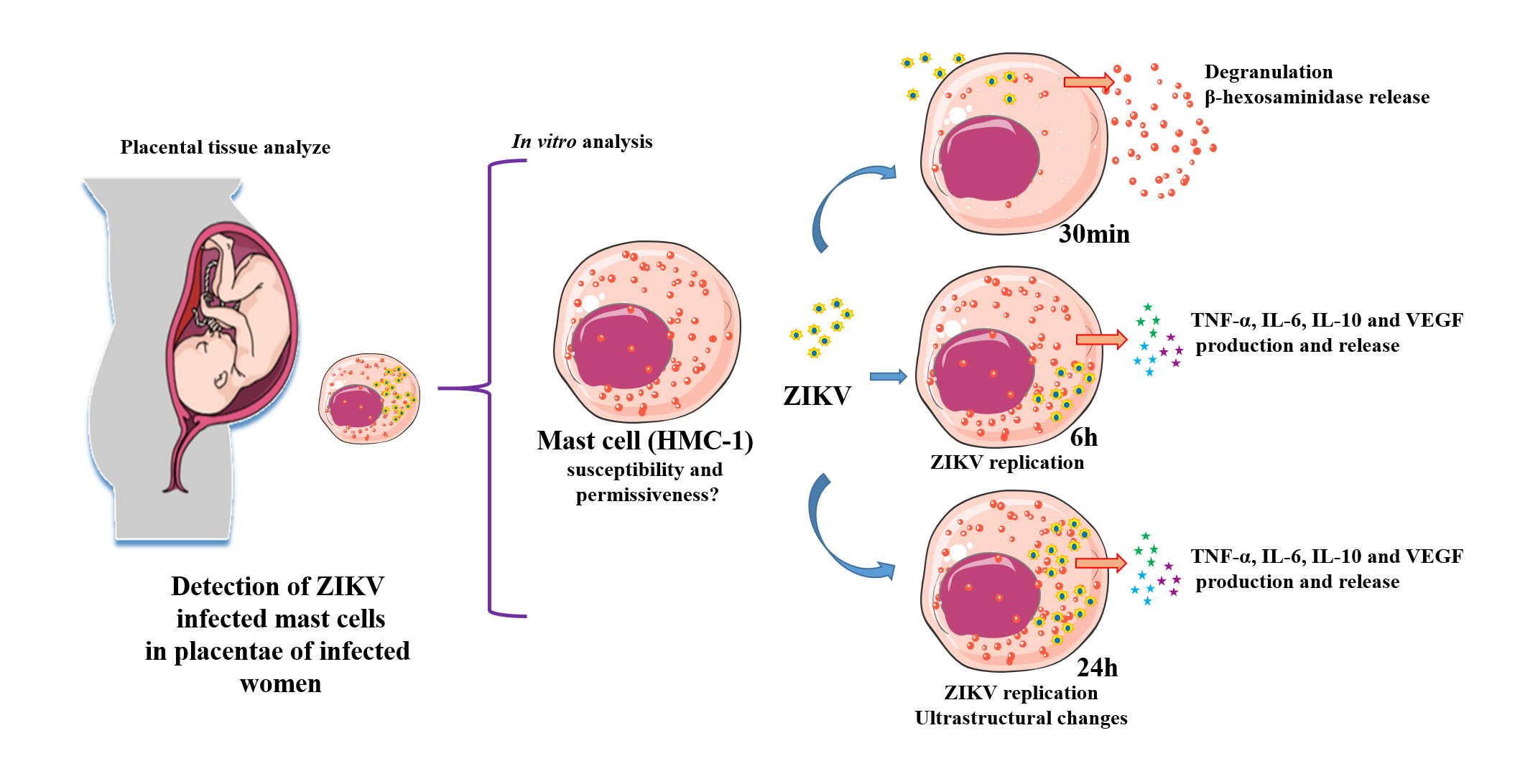Zika virus (ZIKV) is an emergent arthropod-borne virus whose outbreak in Brazil has brought major public health problems. Infected individuals have different symptoms, including rash and pruritus, which can be relieved by the administration of antiallergics. In the case of pregnant women, ZIKV can cross the placenta and infect the fetus leading to congenital defects. We have identified that mast cells in the placentae of patients who had Zika during pregnancy can be infected. This led to our investigation on the possible role of mast cells during a ZIKV infection, using the HMC-1 cell line. We analyzed their permissiveness to infection, release of mediators and ultrastructural changes. Flow cytometry detection of ZIKV-NS1 expression 24h post infection in 45.3% of cells showed that HMC-1 cells are permissive to ZIKV infection. Following infection, β-hexosaminidase was measured in the supernatant of the cells with a notable release at 30 min. In addition, an increase in TNF-α, IL-6, IL-10 and VEGF levels were measured at 6h and 24h post infection. Lastly, different intracellular changes were observed in an ultrastructural analysis of infected cells. Our findings suggest that mast cells may represent an important source of mediators that can activate other immune cell types during a ZIKV infection, which has the potential to being a major contributor in the spread of the virus in cases of vertical transmission.
- Zika virus
- mast cells
- placenta
 Zika fever is an important Arbovirus-caused disease that has surfaced in numerous countries in Asia, Africa and America [1]. The etiological agent of this disease, Zika virus (ZIKV), was initially isolated in 1947 from the blood of sentinel Rhesus monkeys during a study on yellow fever transmission in the Zika forest of Uganda, which gave rise to its name [2][3]. Transmission of the ZIKV is primarily through bites of infected Aedes mosquitos, with the most common vectors being Aedes aegypti and Aedes albopictus, but it can also happen by vertical transmission [4,5]. As a result of vertical transmission, there were alarming cases of Congenital Zika Syndrome, as the virus could cause damage to the placenta, infect placental cells and reach the fetus [6]. A ZIKV particle has a diameter of 25–30 nm and is a member of the Flaviviridae family that shares many similarities with other more widely known related viruses such as dengue, West Nile, Japanese encephalitis and yellow fever [4,7]. It has a single-stranded RNA genome with a positive polarity of 11 Kb and encodes a polyprotein precursor that is processed into the structural proteins such as capsid (C), pre-membrane (prM) and envelope (E) along with seven non-structural proteins (NS1, NS2A, NS2B, NS3, NS4A, NS4B and NS5) [8,9].
Zika fever is an important Arbovirus-caused disease that has surfaced in numerous countries in Asia, Africa and America [1]. The etiological agent of this disease, Zika virus (ZIKV), was initially isolated in 1947 from the blood of sentinel Rhesus monkeys during a study on yellow fever transmission in the Zika forest of Uganda, which gave rise to its name [2][3]. Transmission of the ZIKV is primarily through bites of infected Aedes mosquitos, with the most common vectors being Aedes aegypti and Aedes albopictus, but it can also happen by vertical transmission [4,5]. As a result of vertical transmission, there were alarming cases of Congenital Zika Syndrome, as the virus could cause damage to the placenta, infect placental cells and reach the fetus [6]. A ZIKV particle has a diameter of 25–30 nm and is a member of the Flaviviridae family that shares many similarities with other more widely known related viruses such as dengue, West Nile, Japanese encephalitis and yellow fever [4,7]. It has a single-stranded RNA genome with a positive polarity of 11 Kb and encodes a polyprotein precursor that is processed into the structural proteins such as capsid (C), pre-membrane (prM) and envelope (E) along with seven non-structural proteins (NS1, NS2A, NS2B, NS3, NS4A, NS4B and NS5) [8,9].This entry is adapted from the peer-reviewed paper 10.3390/cells9040975
References
- Didier Musso; Albert I. Ko; David Baud; Zika Virus Infection - After the Pandemic.. New England Journal of Medicine 2019, 381, 1444-1457, 10.1056/NEJMra1808246.
- Didier Musso; Duane J. Gubler; Zika Virus. Clinical Microbiology Reviews 2016, 29, 487-524, 10.1128/CMR.00072-15.
- A.W.R. McCrae; B.G. Kirya; Yellow fever and Zika virus epizootics and enzootics in Uganda. Transactions of The Royal Society of Tropical Medicine and Hygiene 1981, 76, 552-562, 10.1016/0035-9203(82)90161-4.
